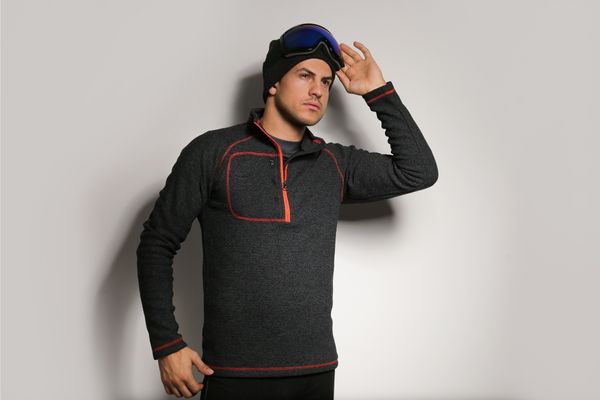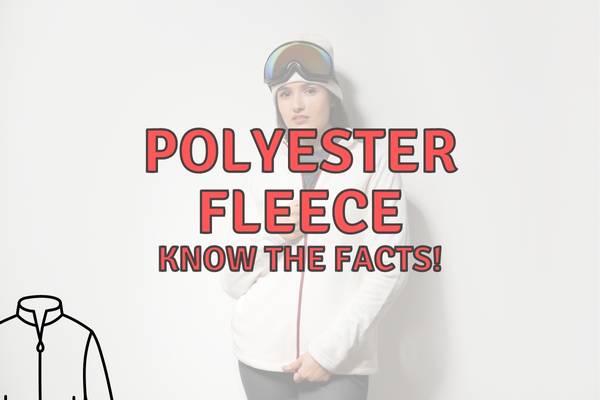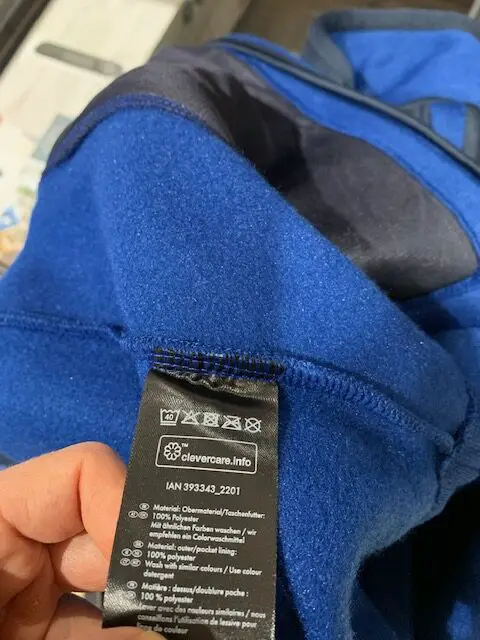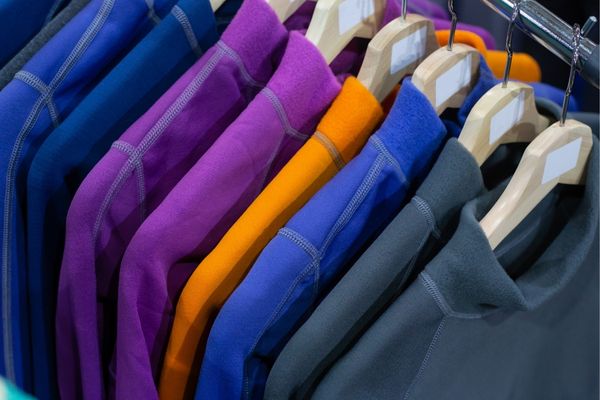As temperatures drop and the need for cozy outerwear arises, you may find yourself pondering the world of fleece fabrics.
Two popular choices are polar fleece and microfleece, both offering warmth and comfort in colder weather.
But what sets them apart? Join us as we unravel the differences and similarities between these two fabulous fabrics, weigh their pros and cons, and ultimately help you decide which one suits your needs best.
Polar Fleece Vs. Micro Fleece – key differences:
- Polar fleece is thicker and provides more insulation, making it ideal for colder climates and heavy-duty outerwear like jackets or blankets.
- Microfleece is softer and more lightweight, suitable for milder temperatures or as a base layer under heavier clothing when additional insulation is needed.
- Both types of fleece offer moisture-wicking properties, easy care maintenance, durability, and are made from synthetic fibers like polyester.
- When choosing between the two fabrics, consider factors such as climate, intended use, personal preferences for softness and thickness, as well as budget constraints to determine which one suits your needs best.
Contents
Understanding Polar Fleece and Micro Fleece
Fleece is a synthetic fabric commonly used for winter clothing due to its warmth and insulation properties, with two popular types being polar fleece and microfleece.

Polar Fleece: Warmth And Thickness
Polar fleece, a popular fabric choice for winter clothing, offers exceptional warmth and thickness. Its creation in the 1970s was a revolutionary development in textile manufacturing as it provided an effective insulation layer without adding excessive weight.
This well-loved material can be found in various forms of cold weather garments such as jackets, hats, gloves, blankets, and scarves. The densely knitted fibers add to its warmth retention capabilities – perfect for outdoor enthusiasts who need added protection against frigid temperatures.
Additionally, polar fleece is known for its moisture resistance which helps keep you dry during those snowy outings or spontaneous rain showers in colder climates.
Microfleece: Softness And Lightweight
Compared to polar fleece, microfleece is much softer to the touch and lightweight in texture. It is often used for projects that require a delicate and gentle fabric like baby clothes or blankets.
Microfleece can range from 100 weight or less, making it the thinnest of all fleece types. Despite its lightness, microfleece still retains warmth and insulation properties while also being highly breathable due to its synthetic fiber composition.
Additionally, microfleece has excellent moisture-wicking abilities which help keep wearers dry during physical activity or in humid climates.
Differences Between Polar Fleece And Microfleece
Polar fleece is thicker and provides more warmth, while microfleece is softer and more lightweight; read on to learn about other differences between these two fabrics!
Warmth And Insulation
Polar fleece and microfleece both offer warmth and insulation, but the level of each varies between the two fabrics. Polar fleece is much thicker than microfleece, making it better suited for colder temperatures where more insulation is necessary.
It traps body heat close to your skin, keeping you warm even in freezing temperatures.
On the other hand, microfleece provides a lighter layer of warmth because it is thinner and less insulating than polar fleece. This makes it ideal for milder climates or as a base layer under heavier clothing when additional insulation is needed.
Microfleece also doesn’t add bulkiness or restrict movement compared to heavier outerwear made from polar fleece.
Softness And Comfort
Both polar fleece and microfleece are known for their soft textures, but there are differences in how they feel when worn. Microfleece is the softer of the two fabrics, with a silky smooth texture that feels gentle against the skin.
This makes it a great choice for sensitive skin or those who want to wear something comfortable all day long.
Polar fleece is not as soft as microfleece, but it has a plush texture that still offers comfort and warmth. It is thicker and denser than microfleece, which gives it more structure and makes it ideal for use in outerwear like jackets or blankets.
If you prefer a fabric with more substance to wrap yourself up in on cold winter nights, then polar fleece might be the better option for you.
Durability And Lifespan
Both polar fleece and microfleece are durable fabrics that can last for a long time with proper care. However, since microfleece is thinner and softer than polar fleece, it may not hold up as well in heavy use or frequent washing.
That being said, both types of fleece are synthetic materials made from polyester fibers which tend to have a longer lifespan than natural fabrics like cotton or wool. Additionally, both types of fabric are easy to care for and maintain their shape after multiple washes.
Price And Affordability
When it comes to price and affordability, there are differences between polar fleece and microfleece. Generally speaking, microfleece tends to be more expensive than polar fleece due to its softer texture and higher quality manufacturing process.
The cost of purchasing either polar fleece or microfleece can vary greatly depending on the brand, size of the garment or item being purchased, and where it is being sold.
For those looking for a budget-friendly option without sacrificing quality, polar fleece may be the better choice due to its lower cost. However, if softness and comfort are top priorities for you, then investing in a higher-priced microfleece garment may be worth the extra cost in terms of overall satisfaction with your purchase.

Similarities Between Polar Fleece And Microfleece
Both polar fleece and microfleece are synthetic fabrics that offer moisture-wicking properties, easy care and maintenance, and comfortable breathability.
Moisture-wicking And Breathability
Both polar fleece and microfleece are excellent at moisture-wicking, meaning they draw sweat away from the skin and move it to the outer layer of the fabric where it can evaporate.
This feature is especially beneficial for outdoor activities or exercise where staying dry is important for comfort and warmth retention. Additionally, both types of fleece are breathable fabrics, which allows air to flow through the material, preventing overheating during physical activity or in warmer weather.
However, microfleece tends to be slightly more breathable than polar fleece due to its lighter weight construction.
Easy Care And Maintenance
Both polar fleece and microfleece are easy to care for and maintain. They do not require any special treatment or handling, making them very convenient fabrics for everyday wear.

Fleece can be machine washed and dried without losing its shape or texture. It is also resistant to wrinkles and fading, which means that it does not need ironing or dry cleaning.
Microfleece is even more low maintenance than polar fleece because it dries quickly due to its lightweight nature. This makes it perfect for travel clothes where laundering facilities may be limited.
Synthetic Fabric Composition
One key similarity between polar fleece and microfleece is that they are both made from synthetic fibers such as polyester, nylon or acrylic. These materials make the fabric lightweight and easy to care for, which is especially important when considering outdoor clothing items.
Synthetic fabrics are also known for their durability and resistance to damage from things like water, sunlight or insects. For example, a fleece jacket made of polyester will not retain moisture like cotton would if caught in the rain.
The synthetic composition of these fleece fabrics makes them ideal for cold weather clothing because they offer great insulation properties while remaining light enough to layer underneath other garments.
Choosing The Best Fleece For You
Consider your intended use and personal preferences for thickness, softness, and warmth when choosing between polar fleece and microfleece.
Consider Climate And Intended Use
Before choosing between polar fleece and microfleece, it is important to consider where and how you will be using the fabric. Here are some factors to think about:
– Climate: If you live in a colder climate or plan on using the fleece for outerwear during the winter months, polar fleece may be a better option due to its thicker and more insulating properties. However, if you live in a milder climate or plan on using the fleece for base layer clothing, microfleece may work better as it is lighter weight and more breathable.
– Intended use: What do you plan on making with the fleece? Polar fleece is commonly used for jackets, blankets, and other outerwear while microfleece is often used for base layer clothing like long underwear and leggings. If you’re unsure of which one to choose, consider what type of clothing or accessory you need and research which type of fleece would work best for that application.
Remember that there is no right or wrong choice when it comes to polar fleece vs microfleece – it ultimately comes down to personal preference and intended use.
Personal Preferences For Thickness And Softness
When it comes to choosing the best fleece for you, personal preferences for thickness and softness play a significant role. Some people prefer thicker fleece for maximum warmth and insulation, while others find thinner microfleece more comfortable due to its soft texture and lightweight feel.
For example, if you plan on using your fleece as outerwear during cold weather activities like skiing or snowboarding, then polar fleece may be the better option because of its thicker and more substantial fabric composition.
Ultimately, finding the right balance between thickness and softness will depend on your personal preferences and comfort needs.
Budget Constraints
Cost is an important factor to consider when choosing between polar fleece and microfleece. Polar fleece tends to be less expensive than microfleece due to its thickness and durability.
Consider how frequently you plan on using your fleece garment – a jacket that will see daily wear may warrant a heavier investment in high-quality fabric, while occasional use items like blankets could be made from more affordable materials without compromising performance.
Check Label And Test The Fabric
When choosing between polar fleece and microfleece, it’s important to check the label for the fabric’s composition. Look for a high percentage of polyester or acrylic blends, as these materials are commonly used in both types of fleece.
It’s also advisable to test the fabric before purchasing it, if possible.
Another consideration is examining the thickness and weight of each type of fleece. Polar fleece is thicker and heavier than microfleece, which may make it more suitable for outerwear like jackets or blankets.
Ultimately, whether you choose polar fleece or microfleece depends on your personal preference regarding softness, warmth retention, durability and budget constraints.
Polar Fleece Vs Microfleece – Which Is Best For You?
Compare the pros and cons of each to decide which one suits you best.
Pros And Cons Of Each
Understanding the pros and cons of polar fleece and microfleece can help you make an informed decision when choosing the best fabric for your needs. Here’s a comparison table to highlight these differences:
| Factors | Polar Fleece | Microfleece |
|---|---|---|
| Warmth and Insulation | Provides excellent warmth and insulation, making it suitable for colder weather and heavy-duty outerwear. | Less insulating compared to polar fleece, but still offers warmth for mild to cool temperatures, often used as a base layer. |
| Softness and Comfort | Soft and comfortable, but not as soft as microfleece. | Exceptionally soft and comfortable, often used for children’s and baby clothing. |
| Durability and Lifespan | Highly durable and long-lasting, withstanding regular wear and tear. | Also durable but slightly more prone to pilling than polar fleece. |
| Price and Affordability | Generally more expensive due to its thickness and warmth. | More affordable option, as it is thinner and requires less material. |
| Breathability | Breathable, but generally less so than microfleece. | Offers a slightly higher breathability factor than polar fleece. |
| Flexibility | Flexible, but not as much as microfleece due to its thicker nature. | Thinnest and most flexible of all fleece types, allowing for greater freedom of movement. |
| Common Uses | Outerwear, jackets, and blankets. | Base layer clothing, leggings, long underwear, and children’s clothing. |
By considering these pros and cons, you can determine which type of fleece will better serve your specific needs and preferences.
Specific Use Cases
Polar fleece and microfleece have their own unique properties that make them ideal for different uses. Here are some specific use cases for each type:
Polar Fleece:
– Jackets and outerwear for cold weather
– Blankets and throws for warmth and insulation
– Pet sweaters to help keep furry friends warm in winter
– Pillows and cushions for added comfort and warmth
Microfleece:
– Base layer clothing such as thermal leggings, long underwear, and socks
– Baby blankets, onesies, and sleep sacks due to their softness
– Lightweight jackets or pullovers for outdoor activities where insulation is still necessary but a lot of movement is required.
– Athletic wear as lightweight hoodie’s which can easily wick off sweat while keeping you warm.
These are just a few examples of the many versatile uses for both polar fleece and microfleece fabrics. Ultimately, the choice between the two will depend on your individual needs in terms of warmth, softness, durability, affordability, and intended use.
Personal Preferences And Needs
When choosing between polar fleece and microfleece, personal preferences and needs play a crucial role. Some people prefer the thickness and warmth of polar fleece, while others prefer the softness and lightweight feel of microfleece.
It’s important to consider climate conditions and intended use when selecting a fabric. For cold weather outdoor activities like skiing or hiking, polar fleece may be the best choice due to its insulation properties.
On the other hand, for indoor use or layering under outerwear, microfleece may be more appropriate because it is thin enough to avoid bulkiness but still provides warmth retention.
Final Decision Making Factor
When it comes to deciding between polar fleece and microfleece, the final decision-making factor often comes down to personal preference and intended use. For example, if you’re planning on using the fleece for outdoor activities in colder temperatures, you may prefer the thicker warmth of polar fleece.
It’s also important to consider your budget and how much you want to spend on a particular item of clothing or fabric. While both types of fleece are generally affordable, there can be differences in price depending on brand and quality.
Checking the label and testing out different fabrics before making a purchase can also help ensure that you choose the best option for your specific needs.
Conclusion
In conclusion, understanding the differences and similarities between polar fleece and microfleece is crucial when selecting the right fabric for your needs. While polar fleece offers warmth and thickness, microfleece boasts softness and lightweight comfort.
Both types provide moisture-wicking capabilities, easy care maintenance, and a synthetic fabric composition. When choosing between the two, consider factors such as climate, intended use, personal preferences for softness and thickness, as well as budget constraints.
FAQs
Is micro fleece warmer than cotton?
Yes, micro fleece is generally warmer than cotton. This is because micro fleece is made from synthetic materials that trap heat more effectively than cotton, which is a natural fiber that does not retain heat as well.
What is the difference between microplush and fleece?
Microplush and fleece are both types of soft, warm fabrics commonly used for blankets and clothing. However, microplush is made of finer fibers than fleece, giving it a smoother and more velvety texture. Fleece, on the other hand, is made of thicker, coarser fibers and has a more fluffy texture. Both fabrics are warm and cozy, but microplush is generally considered to be more luxurious and soft to the touch.
What is micro fleece fabric for?
Micro fleece fabric is a lightweight, soft, and warm material that is commonly used for making clothing such as jackets, sweaters, and blankets. It is also used for outdoor and athletic wear due to its moisture-wicking and quick-drying properties.
What are the disadvantages of polar fleece?
Polar fleece is made from synthetic fibers, which means it is not biodegradable and can contribute to environmental pollution. It also has a tendency to pill and lose its shape over time, and it is not as breathable as natural fibers like cotton or wool.
What’s the difference between micro fleece and cotton?
Micro fleece is a synthetic fabric that is lightweight, breathable, and quick-drying, while cotton is a natural fabric that is soft, comfortable, and breathable but not as quick-drying as micro fleece. Micro fleece is often used in outdoor clothing and activewear, while cotton is commonly used in everyday clothing.






